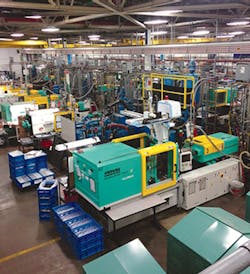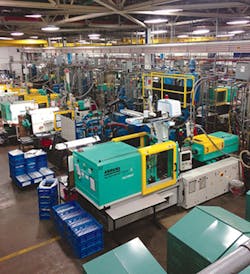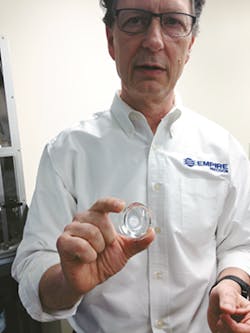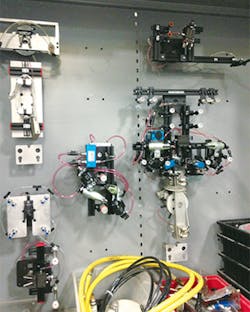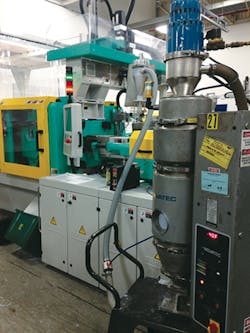Empire meticulously chooses machinery and equipment
At custom injection molder Empire Precision Plastics, Rochester, N.Y., officials apply a rigid, exacting process to the selection of new machinery and equipment. The decision-making is so rigorous, in fact, that just the testing of different brands of dryers required nearly six months as part of the company's upgrade of drying technology. Empire's products are used in a number of end markets including the optics, medical, military, aerospace and firearms industries.
"Our guys looked at the dryers in intervals and we were checking to see from a maintenance standpoint how they held up. It was a long process because it was an important decision for our company," COO Bob Zygulski said. Officials were looking for consistency of drying and evaluated the equipment for over-drying and under-drying, both of which can damage the material. They looked at different kinds of dryers, including desiccant, compressed air and vacuum.
"They all have their place and some work better in our environment than others," said President and CEO Neal Elli. Officials haven't made a dryer decision yet. One of Empire's newest dryers is a Conair MDCW desiccant wheel-style dryer.
The same technique is applied to every machinery and equipment purchase under the direction of Elli, who coordinated Plastics Machinery Magazine's group interview of Empire's eight-member technical team.
The company is evolving under Elli's guidance, with a 10-year goal of reaching $50 million in sales. Targeted capital expenditures to stay on the cutting edge of technology are critical to meeting that mark. Empire's current plant is 42,500 square feet and officials are adding 26,500 square feet, including a technology center where pre-production testing will occur. The center will have its own molding machines and auxiliary equipment.
Elli and two other members of the team strolled the aisles of NPE last year to scrutinize equipment that could be used within Empire's plant.
When it comes to choosing primary machinery or auxiliary equipment, Elli said that the selection process is more difficult today compared to years ago because technology is moving at a faster pace. Once a company invests in a particular piece of equipment, it is frozen in time.
"When you buy it, you own it, and if you don't pick wisely, then you have bad technology that you're going to have for five to seven years maybe," said Jon Harvey, manufacturing tooling engineer.
"So your challenge is: when do you bring in new technology and how long do you retain it and upgrade it?" Elli said. "A lot of the stuff that is happening now is that molding machines are more accurate, dryers are better with dew point sensing, mold temperature controllers are more energy efficient and all of them have the ability for output such that you can track it. We've brought in different machines where we can and tested them. We did a ton of testing on dryers to see what works in our environment with the kinds of materials we handle. We do a really broad spectrum [of materials]. It's difficult. But you cannot stick with old technology, the proven and reliable, because it isn't efficient enough anymore."
Ultimately, the selections come down to what best serves the needs of Empire's customers.
"It is all about our customers and making sure we have the right continuous improvement strategy on the equipment side to be able to deliver them the high-quality product that they want," he said.
CHANGING THE WAYPURCHASING DECISIONS ARE MADE
The testing is part of Elli's goal to have his team involved in the purchasing decisions. Elli co-founded Empire in 1992 and is on a mission to promote team involvement in equipment purchases.
"For a small company, Neal is not afraid to make ... investments and improvements," said Zygulski. "We have decided to do this more as a team as opposed to just Neal and I looking at things." In addition to the eight people in the interview with PMM, about six others from within the company are involved in the decision on what machines to buy.
"We are going to have a working lunch and it's going to be a good three- or four-hour meeting where we've compiled various quotes, various ideas and to use a phrase from Neal, we want to talk about what is the company going to look like a year from now? What is the company going to look like three years from now? We kick around numbers all the time, like where we'd like to see the company financially, from the top end, we're trying to get a lot of input from the key players here, people that spend a lot of time on the floor on how we are best served with the investments we're going to make. There are a lot of easy ways that you can burn through a lot of cash very quickly. So how are we going to get the biggest bang for the buck?" Zygulski said.
To Elli, this means focusing on what the production floor needs to do to meet those financial goals.
"What level of automation? How are we going to move parts? What kind of assembly are we going to be doing? Right now, we do pad printing, machining, welding, laser serialization, all kinds of stuff," Elli said. "What is that going to look like on the floor. And then instead of me just setting that goal, which won't work as things become more technologically advanced, I need the people, this group here and the others, that really delve into it, to help me help them paint that picture."
ROBOTICS INTEGRATION,MACHINERY SELECTION
On its continuing lean journey, robotics is at the forefront. Over its history, Empire has relied on a lot of sprue pickers. Officials have been critically analyzing this selection. Why use robots to handle the runners the customer doesn't want? Officials instead want automation tools to handle the customers' parts. One of Empire's initiatives has been to design customized in-house end-of-arm tooling (EOAT). The company has some pneumatically driven robots but has been turning to servo-driven robots, which provide more flexibility.
"We still continue to invest in the automation side of the business and change out some of the older sprue pickers on the machines and install better part-handling robots," said Harvey. "That is a move that we're continuing throughout our growth plans to get better part handling on the machines."
Accuracy has been one of the main drivers for robotics, he said. "We've turned to doing a lot of end-of-arm tool degating," he said. "So when you're going to actually position the end-of-arm tool to cut the gates on the parts and trim the runners flush off of the parts, you have to have a lot more accurate end-of-arm positioning. When you pick the parts off the tool, you want them in the position that you're going to be cutting the gates at. It's pretty nice to have a servo that you can actually change that position on. Just by changing it in millimeter increments at a time, rather than trying to adjust a stop, a hard-stop, fixed set point where it goes to, it's a lot easier just to set the servo position."
Empire's recent additions for servos have included six robots that were acquired as part of a liquidation sale held by Bausch + Lomb. These are Five Star Automation models. All five have four axes, three of which are servo-controlled; the fourth axis on each is a pneumatic cylinder-operated wrist. The sixth model was a hybrid with a servo-traverse, rail axis and pneumatic crosswise and vertical axis with a pneumatic wrist axis.
Harvey said that one of the robots has been dedicated to hand parts off to a secondary gate-trimming and part-cooling fixture on one of Empire's 75-ton electric Sumitomo presses. Another robot handles some degating operations that are incorporated in the EOAT itself on one of Empire's 300-ton Arburg presses. The remaining robots are used primarily to increase Empire's ability to handle parts instead of runner or sprue removal. These are mounted on a 242-ton Arburg and a 165-ton Arburg electric. The hybrid robot is mounted on a 75-ton Sumitomo electric.
Empire also brought in six robots from Arburg as part of integrated units with molding machines. Empire has two 55-ton Arburg electrics for molding a medical part. These machines' robots now can separate parts for better product handling and control.
Staying current with technology doesn't always mean bringing in new equipment. Ranger Automation Systems Inc., Shrewsbury, Mass., completely redesigned one of Empire's Star Automation Cartesian models, converting it from pneumatically controlled axes to servo.
Primary equipment purchases in 2015 were not for additional capacity, Elli said. "We're looking at our older, more tired hydraulics on the floor and deciding which ones we'd like to cycle off the floor and replacing them with newer, more efficient technology," he said. "We are bringing them in coupled with servo-robot technology for more accuracy and high-speed part removal and a higher scale of automation."
Empire's goal also is to eliminate wasted power. It partnered with the New York State Energy Research and Development Authority to look at areas where energy could best be conserved. "When we look at the hydraulic machines, heat from those machines is wasted power," he said. "Whether it is off the barrel of the molding machine or the heat from the oil, and then we have an air-conditioned shop so we pay to heat the air and then we pay more to get it out of the building. So we're driving a lot of our efforts into eliminating excess heat. If you're creating heat that you don't need, then you are wasting power. That is what drove going from older hydraulics to newer electric presses."
The next category of equipment that is being evaluated is mold temperature controllers. "Right now we're looking at mold temperature controllers that claim they're energy efficient," he said.
APPLYING A DISCIPLINED STRUCTURETO SCIENTIFIC MOLDING
Molding companies roll out scientific molding on a regular basis. At Empire, though, officials are forcing a disciplined structure on the process.
"There is a series of six studies we will do to understand the viscosity, the temperature, the balance of the fill, the pressure loss, and all of those things through the process and it is done every time, all the time, the same way," said Elli. "I've visited companies that have their own spreadsheets but Joe has his spreadsheet, Fred has his own, this guy doesn't want to do it that way, so he has his own thing that he does, and it's all scientific molding, but for us, I wanted the discipline of, 'There is one way to do it and everybody does it that way.' "
Rick Sacheli, senior process and technology engineer, played a key role in how the process was set up. The strategy was to put all the upfront work into engineering the manufacturing process so that when it went live on the production floor, it was consistent and repeatable.
"So the benchmark for us and the thing that sets this is the master process," Elli said. "We go back to that master process. It doesn't mean that continuous improvement can't occur. But that master process is what we use in production."
Empire also has added expertise through recent hires, including John Meabon, tooling and engineering manager, and manufacturing manager Scott Taylor. Meabon has overseen shoring up Empire's process-validation methods.
"We were doing it, but there weren't distinct phases," said Elli. "We would kind of roll from phase to phase. We cleaned it up, and we're good. It seems like every medical device customer has their own strategy, but John brought in a more rigid style to it so that it is a lot cleaner when it goes from stage to stage."
Taylor is overseeing the implementation of the Training Within Industry (TWI) program, which originated during World War II to train workers for industrial production. It is regimented so that different types of learners receive the same type of training.
"Our goal is to implement it here to a 'T,' " Taylor said. "It's one of the key programs over time. Here it is 70 years later, and it's still tried and true. If you teach people this way, they get it and it sticks."
Angie DeRosa, managing editor
Contact:
Empire Precision Plastics,
585-454-4995,
